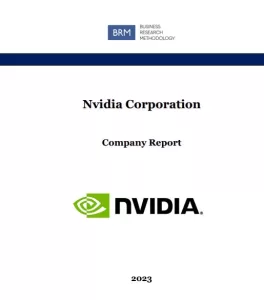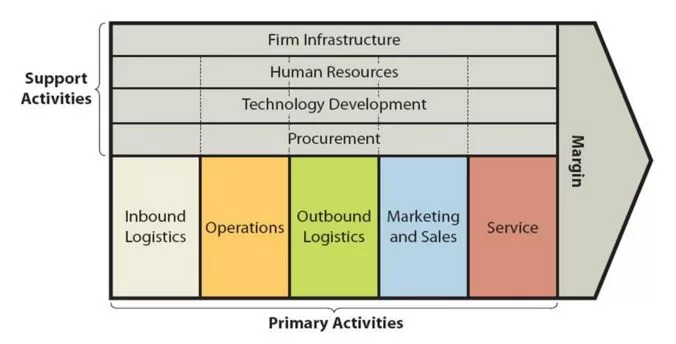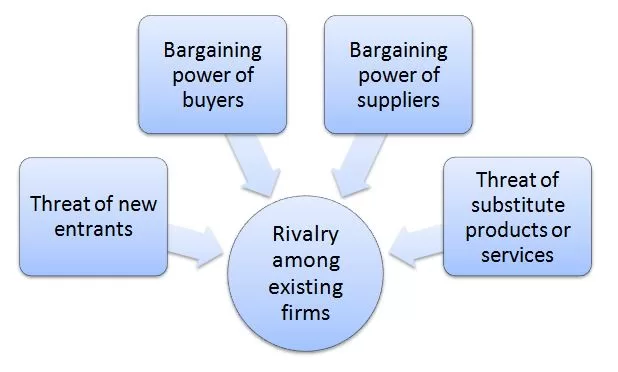Posts by John Dudovskiy

Nvidia is 7th largest company in the world with a market cap of USD 1 trillion. Due to the size and scope of its operations, it is difficult to categorise Nvidia organizational structure within a certain group. However, it is evident that the tech company uses certain elements of functional and hybrid organizational structure. The multinational technology company divides its business practices into various functions such as engineering and product development, supply chain and operations, human resources, finance and accounting and legal and compliance. Functional organizational structure provides a range of advantages for Nvidia. Specifically, employees are assigned into groups on the basis of their competencies and expertise. This allows the groups to achieve their goals with high level of efficiency. Furthermore, functional organizational structure is associated with clear reporting lines and this can enhance the speed and quality of decision making at Nvidia. Nvidia also has certain components of matrix organizational structure in place. Temporary product or project groups are often formed within the multinational technology company and group members report to both, group leader, as well as their direct superiors within the organizational structure. The figure below illustrates the corporate structure of Nvidia: Nvidia Organizational Structure Nvidia Corporation Report contains the above analysis of Nvidia organizational structure. The report illustrates the application of the major analytical strategic frameworks in business studies such as SWOT, PESTEL, Porter’s Five Forces, Value Chain analysis, Ansoff Matrix and McKinsey 7S Model on Nvidia. Moreover, the report contains analyses of Nvidia leadership, business strategy and organizational culture. The report also comprises discussions of Nvidia marketing strategy, ecosystem and addresses issues of corporate social responsibility.

Leadership style at Nvidia is based on the vision and values of its co-founder and long-term CEO Jensen Huang. The leather jacket-clad CEO has been at the helm of Nvidia leadership since 1993. Huang is known for his charismatic leadership style and his ability to inspire and motivate his team. He is deeply involved in the day-to-day operations of the company and is known for his hands-on approach to management. Huang does most of the company-wide presentations and product announcements himself wearing his iconic leather jacket. The CEO is also a strong advocate for innovation and is committed to pushing the boundaries of what is possible with technology. One of Huang’s key strengths as a CEO is his ability to anticipate emerging trends and opportunities in the technology industry. He was an early champion of the potential of graphics processing units (GPUs) for high-performance computing, and he has been instrumental in driving Nvidia’s success in this area. He has also been a vocal advocate for the use of AI in a wide range of applications, from self-driving cars to medical research. Moreover, Huang is known for his ability to build strong partnerships with other companies and to work collaboratively with his team. He has fostered a culture of innovation and excellence at Nvidia, and he is deeply committed to supporting the growth and development of his employees. Celebrating failures is an important element of leadership style at Nvidia. Soon after Huang started the company in 1993, raised the capital and employed 100 people, the technology they developed did not work. Nevertheless, Huang was able to turn around the company by developing new products and the early experience played an important role in cementing corporate culture of intellectual honesty and taking risks. Nvidia Corporation Report contains the above analysis of Nvidia…

NVIDIA business strategy is based on a platform strategy, bringing together hardware and systems, software, algorithms and libraries, and services to create unique value for the markets it serves. The company specializes in markets in which its computing platforms can provide great acceleration for applications. These platforms include processors, interconnects, software, algorithms, systems, and services to deliver unique value. Nvidia business strategy consists of the following three main elements: 1. Benefiting from the first mover advantage. The multinational technology company has benefited from the first mover advantage numerous times to solidify its position in the market. For example, it popularized the term GPU (graphics processing unit), developed Computer Unified Device Architecture (CUDA) and invented deep learning hardware accelerators, such as the Tesla V100 and T4 GPUs. Benefiting from the fist mover advantage is the core of Nvidia business strategy. 2. Prioritizing performance of products over their costs. Nvidia follows product differentiation business strategy and accordingly focuses on superior performance of its products and services over their costs. In other words, the company’s GPUs, data centre and gaming solutions, Drive and Jetson platforms and professional graphics solutions have the most advanced functions and capabilities, but these come at an additional cost for customers. 3. Vertical integration. The company designs and manufactures its own GPUs and other hardware components through fabless manufacturing, and it develops its own software solutions to optimize performance and enable new applications. Nvidia Corporation Report contains the above analysis of Nvidia business strategy. The report illustrates the application of the major analytical strategic frameworks in business studies such as SWOT, PESTEL, Porter’s Five Forces, Value Chain analysis, Ansoff Matrix and McKinsey 7S Model on Nvidia. Moreover, the report contains analyses of Nvidia leadership, organizational structure and organizational culture. The report also comprises discussions of Nvidia marketing strategy, ecosystem…

Founded in 1993 by Jensen Huang, Chris Malachowsky and Curtis Priem, Nvidia Corporation is the multinational technology company that aims to solve the world’s visual computing challenges. The GPU maker is the 7th largest company in the world with a market cap of around USD 1 trillion. For fiscal year 2022 the revenue was a record USD 26.91 billion, up 61 percent from USD 16.68 billion a year ago. Gross margins expanded to 64.9 percent, and earnings per share were USD 3.85, up 123 percent from a year ago (Annual Review, 2022) Nvidia business strategy involves benefiting from the first mover advantage, prioritizing performance of products over their costs and pursuing vertical integration. The company’s co-founder and CEO of 30 years Jensen Huang is famous for his charismatic leadership style and his ability to inspire and motivate his team. The multinational technology company has functional and hybrid organizational structure and divides its business practices into various functions such as engineering and product development, supply chain and operations, human resources, finance and accounting and legal and compliance. Nvidia organizational culture integrates the elements of innovation, intellectual honesty, high performance and inclusion and diversity. Within the framework of Ansoff Grow Matrix the company uses all four growth strategies – market penetration, product development, market development and diversification in an integrated manner. The world’s most valuable semiconductor company possesses certain strengths such as global leadership in GPU market, unique position to benefit from the increasing popularity of artificial intelligence (AI) and more than 370 partnerships revolving around self-driving cars. Furthermore, Nvidia possesses advanced R&D capabilities and these allowed the company to reach its current state. At the same time, the software and fables company has serious weaknesses that need to be addressed. At the moment Nvidia depends on a single type of product…

WeWork value chain analysis is an analytical framework that assists in identifying business activities that can create value and competitive advantage to the co-working giant. Figure below illustrates the essence of WeWork value chain analysis. WeWork Value Chain Analysis WeWork Primary Activities WeWork Inbound logistics Generally, inbound logistics involve receiving and storing raw materials and using them for manufacturing. WeWork offers space as a service and as such its value chain analysis, including inbound logistics are affected by the following main characteristics of service: a) Inseperability. In services production and consumption are simultaneous and they cannot be separated. b) Intangibility. Unlike products, services are intangible and they cannot be touched in physical terms. However, intangibility aspect of services relates to WeWork to a lesser degree compared to other types of services. This is because office spaces and furniture and appliances within offices are tangible items. c) Perishability. Services cannot be stored for the later use or sale. Certain number of desks of a co-working operator staying vacant during a certain period of time means waste and loss for the business. d) Heterogeneity. It is difficult to establish a standard for the quality of services. The quality of services is highly dependent on the perception of each individual user. Inbound logistics for WeWork involve finding suitable places for co-working offices and furnishing these offices as creative and attractive workspaces. WeWork Operations Operations within value chain analysis refer to the process of transforming raw materials into products ready to sell. For service companies such as WeWork operations include the processes that make the services possible and deliver the experiences to consumers. WeWork operates a network of 756 locations in 38 countries as of December 2021[1]. The co-working giant attempts to design its offices and workspaces in a creative manner that…

Porter’s Five Forces analytical framework developed by Michael Porter (1979)[1] represents five individual forces that shape an overall extent of competition in the industry. WeWork Porter’s Five Forces is illustrated in figure below: Porter’s Five Forces Threat of new entrants in WeWork Porter’s Five Forces Analysis Threat of new entrants into the flexible workspace industry is significant. The following are the major factors that affect the threat of new entrants into the flexible workspace industry. 1. Time of entry. Increasing numbers of start-ups and solopreneurs are increasing demand for flexible workspace. Furthermore, COVID-19 pandemic has proved the inefficiency of committing to long-term traditional real estate lease agreements for many businesses. Instead, companies of all sizes increasingly prefer to flexible workspace to accommodate their changing needs for desks throughout the year. This tendency may motivate new players to enter the industry. 2. Massive capital requirements. Leasing real estate and furnishing them into creative open space is expensive. Investors may not be keen to finance such business proposals due to low profit margins and long payback periods of their investment. Massive capital requirement is a serious barrier for new entrants. WeWork’s co-founder and former CEO Adam Neumann was able to raise billions of dollars for the business by positioning the company as an internet technology company, rather than real estate company it is. 3. Lack of technological barrier. Unlike technological and manufacturing businesses there are no know-how barriers to enter the flexible workspace industry. There is no secret formula or advanced software a company needs to develop to enter the industry. Massive capital requirement is the only barrier and the absence of other barriers may attract new players into the industry. Bargaining power of buyers in WeWork Porter’s Five Forces Analysis The bargaining power of buyers in flexible workspace sector…

WeWork marketing communication mix comprises communication channels to communicate the marketing message to the target customer segment. These channels are print and media advertising, sales promotions, events and experiences, public relations and direct marketing. WeWork Print and Media Advertising The global flexible workspace provider uses print and media advertising extensively. The company uses TV, radio, magazines, newspapers, billboards and posters to convey their markeing message to potential customers. Specifically, WeWork print and media advertisements aim to encourage entrepreneurs and business owners to re-image their workspace to be a flexible and creatively designed to make the work process a highly rewarding experience. Recently, WeWork India started a brand campaign, ‘Great Inspires Great’, launching a series of three product films featuring their core products ‘On-demand’, ‘Managed Office’, and ‘Space as a Service’[1]. WeWork Sales Promotions Sales promotions can be defined as a marketing strategy where a company uses short-term campaigns to spark interest and create demand for a product, service or other offers. We work is not famous for using various forms of sales promotions techniques. The global flexible workspace provider occasionally offers free gifts as a sales promotion strategy. For example, in 2020 WeWork offered one month trial gift for new All Access subscription members. The global flexible workspace provider does not use seasonal sales promotions, discount vouchers, money off coupons, competitions, discount vouchers, loyalty program sales promotions methods. This is due to nature of products and services the company offers. WeWork Inc. Report contains a full analysis of WeWork marketing communication mix and WeWork marketing strategy in general. The report illustrates the application of the major analytical strategic frameworks in business studies such as SWOT, PESTEL, Porter’s Five Forces, Value Chain analysis, Ansoff Matrix and McKinsey 7S Model on WeWork. Moreover, the report contains analyses of WeWork leadership,…

WeWork marketing mix (WeWork 7Ps of marketing) comprises elements of the marketing mix that consists of product, place, price, promotion, process, people and physical evidence. Product Element in WeWork Marketing Mix (WeWork 7Ps of Marketing) WeWork offers the following three products and services: Space as a service. Coworking space for small to medium sized businesses and flexible space solutions for enterprise companies. WeWork access. Workspaces around the world by the hour, day, or month through monthly subscription All Access product or pay-as-you-go On Demand product. Services within access category are similar to a gym membership model in a way that membership sales are not limited by the desk capacity within premises. WeWork Workplace. Workspace management software solution. It is software for landlords for online booking of desks, offices, collaboration hubs, and meeting rooms, in addition to providing meaningful utilization analytics, and helping to optimize space across assets. Place Element in WeWork Marketing Mix (WeWork 7Ps of Marketing) The co-working giant has a network of 756 locations in 38 countries, including 277 locations in the US as of December 2021. Customers can find information regarding the address of each location on company’s website and purchase WeWork products and services in any of these locations. Furthermore, customers can book flexible workspace using WeWork app at a time and place that is convenient to them. Price Element in WeWork Marketing Mix (WeWork 7Ps of Marketing) WeWork pricing strategy includes the following elements: Flexible pricing. The co-working giant applies a wide range of pricing options such as daily pay-as-you-go, as well as, monthly and yearly membership fees. Global flexible workspace provider can also offer custom payment plan for its large enterprise customers. Geographical pricing. As mentioned the workspace provider operates in 38 countries and prices vary in each country to…

WeWork McKinsey 7S model highlights the ways in which seven elements of businesses can be aligned to increase effectiveness. According to this model strategy, structure and systems represent hard elements, whereas shared values, skills, style and staff are soft elements. McKinsey 7S model stresses there are strong links between elements in a way that a change in one element causes changes in others. As it is illustrated in figure below, shared values are placed at the core of WeWork McKinsey 7S model, because shared values guide employee behaviour with implications on their performance. Hard Elements in WeWork McKinsey 7S Model Strategy. WeWork pursues simplification business strategy. Specifically, co-working giant simplifies the notion of flexible workspace and makes it practical for businesses of all sizes through offering space as service. Furthermore, the company is on the path of digitalizing real estate business on the global scale. Structure. Under the leadership of co-founder and former CEO Adam Neumann WeWork organizational structure was chaotic and ineffective. The current CEO Sandeep Mathrani restructured the company to a great extend to make it more simple and transparent. Currently, global flexible workspace provider has an hierarchical organizational structure. Systems. The workspace provider relies on a wide range of systems for its daily operations. These include employee recruitment and selection, team development and orientation, transaction processing systems. Furthermore, customer relationship management, business intelligence, knowledge management systems are also important for WeWork. WeWork Inc. Report contains a full analysis of WeWork McKinsey 7S Model. The report illustrates the application of the major analytical strategic frameworks in business studies such as SWOT, PESTEL, Porter’s Five Forces, Ansoff Matrix and Value Chain analysis on WeWork. Moreover, the report contains analyses of WeWork leadership, business strategy organizational structure and organizational culture. The report also comprises discussions of WeWork marketing strategy, ecosystem…

WeWork segmentation, targeting and positioning is an important tool for the global flexible workspace provider to develop right products and services for right customers. Segmentation involves dividing customers into different groups according to their common needs and common characteristics. Targeting implies selecting specific groups among the population to sell products and services to. Positioning refers to developing elements of the marketing mix that best resonates with the needs and wants of the target customer segment. WeWork uses the following types of positioning: 1. Functional positioning. Functional positioning refers to positioning of products and services that are aimed at solving specific problems customers are facing. Businesses needed flexible workspace solutions without commitment of lengthy and expensive lease. Adam Neumann and Miguel McKelvey saw commercial opportunity in this problem and established WeWork with functional positioning in 2010. 2. Multi-segment positioning. The co-working giant offers services to more than one customer segment in terms of their workspace needs. For example, ‘Space as a service’ category is developed for small and medium sized businesses and enterprise companies. ‘WeWork Access’ category, on the other hand, aims to attract different customer segment, namely sole entrepreneurs at the early stages of their journey in business. The following table illustrates WeWork segmentation, targeting and positioning: Type of segmentation Segmentation criteria WeWork target customer segment Geographic Region 38 countries worldwide Density Mainly urban areas Demographic Age 18-65 Gender Males & Females Life-cycle stage Bachelor Stage: young, single people not living at home Newly Married Couples: young, no children Full Nest I: youngest child under six Full Nest II: youngest child six or over Full Nest III: older married couples with dependent children Empty Nest I: older married couples, no children living with them Occupation Self-employed, professionals, senior manager, executives, business owners Behavioral Degree of loyalty ‘Hard core loyals’ ‘Soft core loyals’ ‘Switchers’ Benefits…
